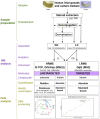Six Decades of Research on Human Fetal Gonadal Steroids
- PMID: 34206462
- PMCID: PMC8268622
- DOI: 10.3390/ijms22136681
Six Decades of Research on Human Fetal Gonadal Steroids
Abstract
Human fetal gonads acquire endocrine steroidogenic capabilities early during their differentiation. Genetic studies show that this endocrine function plays a central role in the sexually dimorphic development of the external genitalia during fetal development. When this endocrine function is dysregulated, congenital malformations and pathologies are the result. In this review, we explain how the current knowledge of steroidogenesis in human fetal gonads has benefited from both the technological advances in steroid measurements and the assembly of detailed knowledge of steroidogenesis machinery and its expression in human fetal gonads. We summarise how the conversion of radiolabelled steroid precursors, antibody-based assays, mass spectrometry, ultrastructural studies, and the in situ labelling of proteins and mRNA have all provided complementary information. In this review, our discussion goes beyond the debate on recommendations concerning the best choice between the different available technologies, and their degrees of reproducibility and sensitivity. The available technologies and techniques can be used for different purposes and, as long as all quality controls are rigorously employed, the question is how to maximise the generation of robust, reproducible data on steroid hormones and their crucial roles in human fetal development and subsequent functions.
Keywords: androgens; detection; estrogens; fetal; human; ovary; quantification; steroidogenesis; testis.
Conflict of interest statement
The authors declare no conflict of interest. The funders had no role in the design of the study, in the writing of the manuscript, or in the decision to publish the results.
Figures




References
-
- Fevold H.R., Lorence M.C., McCarthy J.L., Trant J.M., Kagimoto M., Waterman M.R., Mason J.I. Rat P450 17α from Testis: Characterization of a Full-Length CDNA Encoding a Unique Steroid Hydroxylase Capable of Catalyzing Both Δ 4-and Δ 5-Steroid-17,20-Lyase Reactions. Mol. Endocrinol. 1989;3:968–975. doi: 10.1210/mend-3-6-968. - DOI - PubMed
-
- Wilson J.D., Auchus R.J., Leihy M.W., Guryev O.L., Estabrook R.W., Osborn S.M., Shaw G., Renfree M.B. 5α-Androstane-3α,17β-Diol Is Formed in Tammar Wallaby Pouch Young Testes by a Pathway Involving 5α-Pregnane-3α,17α-Diol-20-One as a Key Intermediate. Endocrinology. 2003;144:575–580. doi: 10.1210/en.2002-220721. - DOI - PubMed
Publication types
MeSH terms
Substances
Grants and funding
LinkOut - more resources
Full Text Sources

